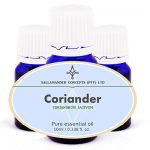Information on Peppermint Essential Oil
Peppermint Essential Oil is extracted from Mentha x piperita of the Labiatae family and is also known as brandy mint and balm mint.
Peppermint Essential Oil, a cooling and refreshing essential oil, is used in aromatherapy to stimulate the mind, increase mental agility and to increase focus, while cooling the skin, reducing redness and calming irritation and itchiness.
It helps to ease spastic colon, migraine, headaches, sinus and chest congestion and boosts the digestive system.
Oil Properties
Peppermint Essential Oil has a fresh, sharp, menthol smell, is clear to pale yellow in color and watery in viscosity.
Origin
It is a native of the Mediterranean, but is now also cultivated in Italy, USA, Japan and Great Britain.
It is a perennial herb that grows up to 1 meter (3 feet) high and has slightly hairy serrated leaves with pinkish-mauve flowers arranged in a long conical shape.
It has underground runners by which it easily propagates.
This herb has many species, and peppermint piperita is a hybrid of watermint (M. aquatica) and spearmint (M. spicata).
According to Greek mythology the nymph Mentha was hotly pursued by Pluto. This caused Persephone, Pluto’s jealous wife, to tread her ferociously into the ground. Pluto then turned her into a herb, knowing that people would appreciate her for years to come.
Peppermint has been cultivated since ancient times in Japan and China.
Evidence of use was found in Egypt in a tomb dating back from 1000 BC.
Extraction
Peppermint Essential Oil is extracted from the whole plant above ground just before flowering.
The oil is extracted by steam distillation from the fresh or partly dried plant and the yield is 0.1 – 1.0 %.
Chemical composition
Some of the chemical components of Peppermint Essential Oil are (-)-Menthol, Menthone,(-)-Menthyl acetate, Neomenthol, 1,8 Cineole, Isomenthone (+)-Limonene, Pulegone
Precautions
Peppermint Essential Oil is non-toxic and non-irritant in low dilutions, but sensitization may be a problem due to the menthol content.
Peppermint essential oil can cause irritation to the skin and mucus membranes and should be kept well away from the eyes and mucous membranes.
Peppermint essential oil should not be used on children up to 3 years of age – it is reported to slow breathing and to cause neurological problems in some children .
Therapeutic properties
The therapeutic properties of Peppermint Essential Oil are analgesic, anesthetic, antiseptic, antigalactagogue, antiphlogistic, antispasmodic, astringent, carminative, cephalic, cholagogue, cordial, decongestant, emmenagogue, expectorant, febrifuge, hepatic, nervine, stimulant, stomachic, sudorific, vasoconstrictor and vermifuge.
For our glossary and explanation of these therapeutic terms, please click here
Uses
Peppermint Essential Oil is excellent for mental fatigue and depression, refreshing the spirit and stimulating mental agility and improving concentration.
It helps for apathy, shock, headache, migraine, nervous stress, vertigo and faintness and in general respiratory disorders, as well as dry coughs, sinus congestion, asthma, bronchitis, pneumonia, tuberculosis and cholera.
For the digestive system, peppermint oil is effective for a range of ailments, as it stimulates the gall bladder and the secretion of bile.
It is used for cramps, dyspepsia, spastic colon, flatulence and nausea and can relieve pain in cases of toothache, aching feet, rheumatism, neuralgia, muscular pains and painful periods.
On the skin, peppermint oil is used to relieve skin irritation and itchiness and also helps to reduce skin redness, where inflammation is present. It is used for dermatitis, acne, ringworm, scabies and pruritus and also relieves itching, sunburn and inflammation of the skin, while at the same time having a cooling action.
Burners and vaporizers
In vapor therapy, peppermint oil can help to increase concentration and to stimulate the mind, as well as sorting out coughs, headaches, nausea and also has value as an insect repellent.
Blended Massage Oil or in the Bath
As a blended massage oil or diluted in the bath, peppermint oil can assist with colic, cramps, back pain, inflamed bowel disorders, spastic colon, catarrh, colitis, circulation, constipation, coughs, diarrhea, sweaty and tired feet, flatulence, headaches, muscular pains, cramps and spasms, neuralgia, nausea, rheumatism and mental fatigue, skin that is red, irritated and itchy, as well as other inflammatory conditions.
Blended in a Cream
When included in a cream or lotion, it will help to ease the sting of sunburn, reduce redness of inflamed skin, reduce itchiness and cools down the skin with its vasoconstrictor properties.
Suggested Dilution Rates
On the skin
Adult:
Face: 0.5% to 1.5%
Body: 0.5% to 3%
Bath: 0.5% to 4%
3 to 36 months:
Do not use this essential oil. Avoid
3 to 6 years:
Face: 0.25% to 0.5%
Body: 0.25% to 0.5%
Bath: 0.0.25% to 0.5 %
6 to 15 years
Face: 0.5% to 1.5%
Body: 0.5% to 2%
Bath: 0.5% to 2%
Pregnancy
Face: 0.5% to 1.5%
Body: 0.5% to 2%
Bath: 0.5% to 2%
- When in doubt consult your doctor / medical professional before use.
- Most professionals and/or Aromatherapists will always err on the side of safety when giving advice regarding the use of essential oils and oleo resins during pregnancy.
- Quite a number of Aromatherapists advise that you should avoid all essential oils completely while pregnant, specifically during the first trimester. This is a very safe approach but may not be necessary at all.
Diffusers and Vaporisers
4 to 8 drops
General:
- When using for the first time – Always use the lowest dilution rate and build up slowly to the maximum. Stop using all essential oils on the skin if irritation or allergy occurs.
- Any advice or instruction received from a medical professional ALWAYS supersedes recommendations or advice found on this website. When in doubt consult your doctor / medical professional.
Summary
Peppermint Essential Oil can assist in nervous disorders and is dramatically effective in stimulating the mind and focusing concentration, for treating the respiratory tract, muscular aches and pains and for some skin problems.
Blends
Although most essential oils blend well with one another, peppermint oil blends particularly well with Benzoin, Eucalyptus, Lavender, Marjoram, Lemon and Rosemary.





